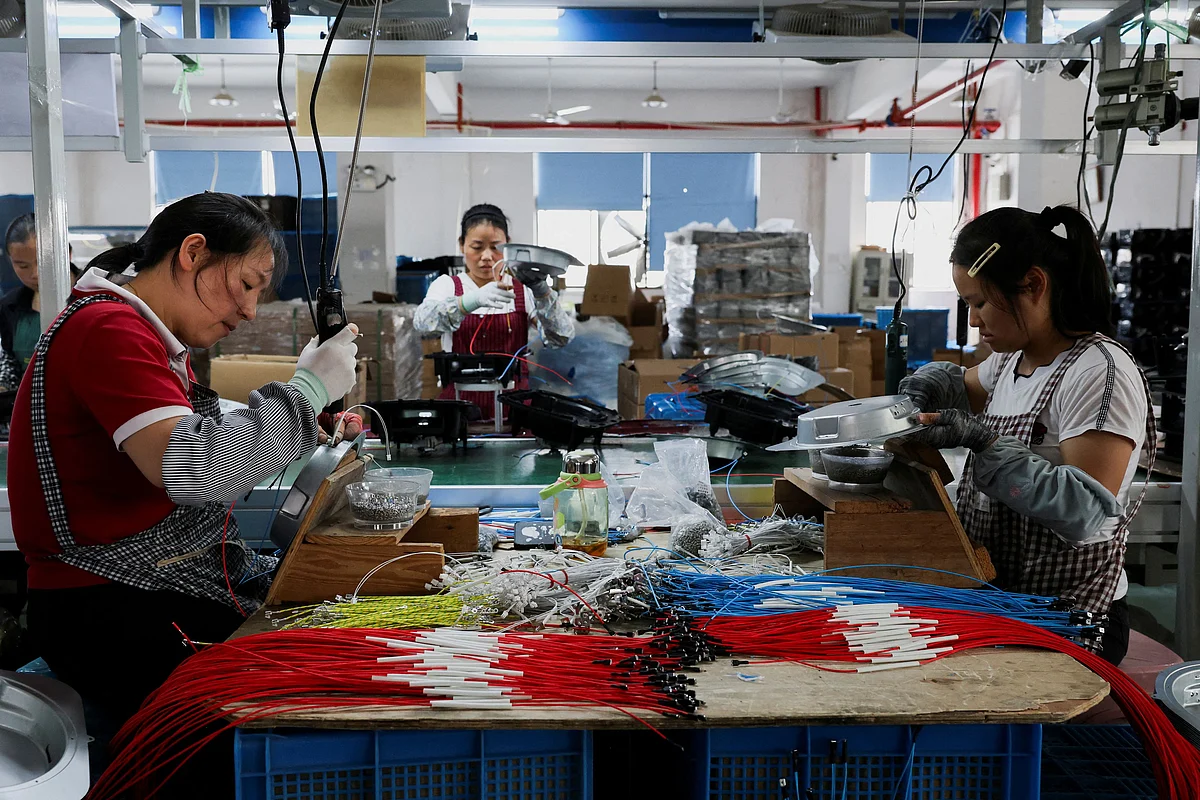China Factory Activity Shrinks Again As Firms Watch For Stimulus, US Trade Deal
China's manufacturing activity shrank for a sixth month in September, an official survey showed on Tuesday, suggesting producers are waiting for further stimulus to boost domestic demand, as well as clarity on a U.S. trade deal.
The official purchasing managers' index (PMI) rose to a six-month high of 49.8 in September versus 49.4 in August. It remained below the 50-mark separating growth from contraction, but topped a median forecast of 49.6 in a Reuters poll.
Recommended For YouThe prolonged slump underlines the twin pressures on China's economy: domestic demand has failed to mount a durable recovery in the years since the pandemic while U.S. President Donald Trump's tariffs have squeezed Chinese factories as well as overseas firms that buy components.
All the same, a separate private-sector survey of factory managers showed the fastest expansion since March, buoyed by rising new orders and accelerated production growth, including an uptick in new export orders.
The two surveys cover different pools of producers, with the National Bureau of Statistics (NBS) placing more emphasis on large- and medium-sized firms focused on domestic sales, while the RatingDog General PMI, compiled by SP Global, which came in at 51.2, up from 50.5 in August, includes a larger share of export-orientated private companies.
"The rebound reflects a seasonal uptick as the summer disruptions are behind us and the government becomes more supportive," said Xu Tianchen, senior economist at the Economist Intelligence Unit, referring to the official PMI's headline figure.
China's economic momentum is marked by swings, he added: a strong first quarter from early stimulus, a slower midyear, followed by a fourth quarter rebound as the government ramps up support measures to meet growth targets.
Markets remained steady following the data, with attention focussed on policymakers' plans for near-term stimulus and a meeting of the ruling Communist Party in October to map out the next five years of China's social and economic development.
Policymakers rolled out a series of consumer loan subsidies in mid-August, a decision vindicated by separate factory output and retail sales data for the month, which saw their weakest growth in 12 months.
Pan Gongsheng, the governor of the People's Bank of China, said last week a range of monetary policy tools to support the economy remained available, but refrained from following the U.S. Federal Reserve with a rate cut, as some economists speculated the central bank might.
Despite signs the $19 trillion economy is losing momentum, authorities appear in no hurry to roll out major stimulus measures, given resilient exports and a stock market rally, market watchers say.
Adding to signs of a slowdown, the official non-manufacturing PMI, which includes services and construction, fell to 50.0 from 50.3 in August, according to the NBS, its worst reading since November.
The NBS composite PMI of manufacturing and non-manufacturing came in at 50.6 in September, compared with 50.5 in August.
"Third-quarter economic activity and inflation data released to date suggest a strong case for further policy support in the coming months," Lynn Song, chief economist for Greater China at ING, said, adding he expected a 10-basis-point rate cut and a 50-bp cut to the amount banks must hold in reserve before the year's end.
The new export orders sub-index contracted for a seventeenth straight month, while employment and factory gate prices also remained firmly in the doldrums.
The EIU's Xu said the combination of strong export performance and weak new orders suggests growth is concentrated in a few firms, making the PMI a less reliable indicator of the country's overall export strength.
China's exports to regional rival India hit an all-time high in August, according to customs data, and shipments to Africa and Southeast Asia are on track for annual records.
But no other country comes close to the consumption power of the U.S., where Chinese producers sell more than $400 billion worth of goods annually, accounting for around 14% of total exports.
Chinese leader Xi Jinping phoned Trump on September 19 for the first time in three months, and while the call appeared to ease tensions, it remains unclear whether it yielded the expected agreement on popular short-video app TikTok, which analysts see as key to a broader trade deal.
Disagreements on technical details appeared to be weighing on negotiations, as Chinese and U.S. trade officials met again last Thursday to revisit issues discussed in talks before this month's Madrid summit, where a framework TikTok deal was reached.
Zichun Huang, China economist at Capital Economics, is "sceptical that economic growth is on the cusp of a sustained rebound."
"Overcapacity remains a problem and the output price components declined, suggesting deflationary pressures remain entrenched," she said.

Legal Disclaimer:
MENAFN provides the
information “as is” without warranty of any kind. We do not accept
any responsibility or liability for the accuracy, content, images,
videos, licenses, completeness, legality, or reliability of the information
contained in this article. If you have any complaints or copyright
issues related to this article, kindly contact the provider above.
Most popular stories
Market Research

- Alt.Town Introduces $TOWN Token Utility Across Platform Services And Launches Valuefi Deposit Event
- BTCC Exchange Maintains 143% Total Reserve Ratio In September 2025 Demonstrating Continued Financial Strength
- Salvium Solves The Privacy Paradox: Salvium One Delivers Mica-Compliant Privacy That Exchanges Can List
- Zebu Live 2025 Welcomes Coinbase, Solana, And Other Leaders Together For UK's Biggest Web3 Summit
- Tapbit At TOKEN2049: Reshaping The Crypto Landscape Through Product Innovation
- Thrivestate Launches“Fly Before You Buy” Program, Enabling International Buyers To Explore Dubai Before Committing






















Comments
No comment